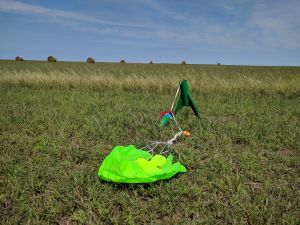2019 Launch Reports
LDRS 38, August 29 - September 2, 2019, Argonia KS
Real Life has gotten in the way of my rocket launching activities for a while, as you can see. However, I did finally get back in the field for LDRS 38, hosted by Kloudbusters on the weekend normally reserved for Airfest.
Local news coverage via Wichita NBC affiliate
Jiminy Cricket, I242

With its hollowed-out nose cone, Jiminy has enough room to pretty comfortably fit a four-grain motor. I didn't want to fly it on a bigger motor until I had worked out a way to put a tracker in it, although as it turned out the tracker wasn't needed. Jiminy carried a Jolly Logic AltimeterTwo, a Jolly Logic ChuteRelease, and a BigRedBee RDF beacon.
| Launch time: | Friday, August 30, 2019, 12:45 pm |
| Weather conditions: | mostly cloudy, wind NE @ 5 mph, 77 F, 64% RH |
| Motor: | Cesaroni Pro38 548I242-15A White |
| Max altitude: | 3623 feet AGL (AltimeterTwo, barometric) |
| Max velocity: | 958 ft/sec (653 mph, Mach 0.85) (AltimeterTwo, accelerometer) |
| Max acceleration: | 15.3 G (AltimeterTwo, accelerometer) |
* That V seems really sketchy - altitude matches the sim almost exactly, but the sim predicted 544 mph - over 100 mph lower.
Jiminy landed upright in mowed hay field on the north side of 80th, right across from the away RSO. Very easy recovery, but the body tube was zippered.
Kestrel, K260
First flight of my first minimum-diameter rocket, which I had intended to fly at the previous year's Airfest. Weather on Saturday was too cloudy to fly, so I only got one of my two planned flights in (the other motor was a K660). Kestrel carried an Altus Metrum TeleMega.
| Launch time: | Sunday, September 1, 2019, 9:45 am |
| Weather conditions: | fair, wind SSE @ 6 mph, 72 F, 81% RH |
| Motor: | Cesaroni Pro54 2285K260-P Classic Longburn |
| Max altitude: | 20846 feet AGL (TeleMega, GPS), 19761 feet AGL (TeleMega, barometric) |
| Max velocity: | 1766 ft/sec (1204 mph, Mach 1.6) (TeleMega, accelerometer) |
| Max acceleration: | 24 G (TeleMega, accelerometer) |
Kestrel landed in a plowed field about 1/4 mile NE of the intersection of Dixon Rd. and Highway 44, about a mile southeast of the launch pad. Easy recovery and there was no damage to the rocket. All recovery deployed, but the primary main charge did not fire. The TeleMega stopped acquiring data 270 seconds after launch, which was also about the time the main parachute should have deployed. I later discovered that one of the electrical connections to the magnetic power switch, held by a #4 machine screw, was loose. Earlier in the trip, the computer had mysteriously switched on while the av-bay was stored in a bin, and I think this loose connection was the reason for both. Lessons: tighten the crap out of all screws which serve as electrical connections, and don't ignore things that mysteriously turn themselves on or off.
GPS track (viewable with Google Earth)
Raw flight data (viewable with AltOS)
Raw flight data (CSV)
Marvin the Martian's Space Oddity, Research O
Sunday, September 1, 2019 Weather conditions at launch time: partly cloudy, wind SSW @ 8mph, 85 F, 59% RH
The St. Louis Rocketry Association club project, led by Dan Welling, took to the skies late on Sunday. Marvin the Martian took off briskly before turning to the south, flying about half a mile horizontally, and pulling the ripcord on his parachutes to abort the mission to Mars. The rocket landed right on the road, making for a convenient recovery. The official investigation revealed that there was a bee in the cockpit with Marvin, causing him to lose control and inadvertently deploy the parachutes.
(TODO: Video by Chuck Haskin)
(TODO: images)
SLRA Club Launch, October 20, 2019, Elsberry MO
Flooding earlier in the year has prevented crops from being planted in the Elsberry fields, so we found ourselves with a long fall flying season there. The first of three scheduled launches was on October 20.
Berthimus Prime, CTI I212
Sunday, October 20, 2019, approx. 10:30am Weather conditions at launch time: cloudy, wind calm, 58 F, 72% RH
I flew Berthimus Prime for the first time on an I212 smoky motor. It had a good boost, but unfortunately a very late ejection (10.2 seconds vs. the 7 seconds I set when building the motor).
NSL 2018 Big Bertha “Berthimus Prime” flight #1:
Motor: Cesaroni Pro38 364I212-14A Smoky Sam
(All data from AltimeterTwo) Altitude: 987 feet AGL Max velocity: 162 mph Burn time: 1.9 s Peak acceleration: 8.2 G Average acceleration: 4.0 G Coast time to apogee: 6.6 s Apogee to ejection: 3.6 s Ejection altitude: 767 feet AGL Descent rate: 15 mph Flight duration: 46.4 s
Result: lower airframe mangled due to late ejection; needs major repair.
(TODO: images)
SLRA Club Launch, ???, 2019, Elsberry MO
Berthimus Prime, CTI I212
Sunday, October 20, 2019, approx. 10:30am Weather conditions at launch time: cloudy, wind calm, 58 F, 72% RH
Undeterred, I repaired Berthimus Prime's airframe by cutting off the mangled section of cardboard tube and replacing it with a Wildman fiberglass tube. Zipper that.
NSL 2018 Big Bertha “Berthimus Prime” flight #2:
Motor: Cesaroni Pro38 700J400-16A Smoky Sam
(All data from AltimeterTwo) Altitude: Max velocity: Burn time: Peak acceleration: Average acceleration: Coast time to apogee: Apogee to ejection: Ejection altitude: Descent rate: Flight duration:
Result:
(TODO: images)






